M
Leave a Legacy of Giving
You can support our mission of changing lives by saving sight in multiple ways!
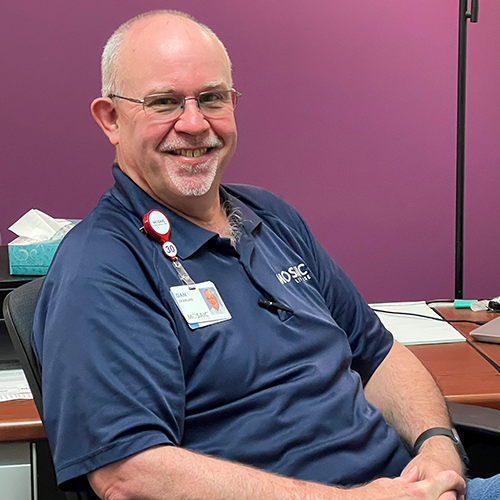

Chaplain Dan Mefford
Dan Mefford has served as a Chaplain for Mosaic Life Care Medical Center in St. Joseph, Missouri for 30 years. “Part of my role here, as all of ours are, is to respond to all end-of-life care crises,” says Chaplain Dan. “We are a part of what they’re going through and are there for the families as well.”
At Mosaic Life Care, the chaplains also serve as the designated healthcare directive educators. When working with families about the healthcare directive, often questions about organ, eye and tissue donation and the individual’s wishes are brought up along with questions about what is available to them.
As the lead chaplain for Mosaic Life Care’s ER and ICU, Chaplain Dan is involved with both Midwest Transplant Network and Saving Sight in the donation process. “Primarily, I work with Midwest Transplant Network and then they connect us to Saving Sight for eye donation,” says Chaplain Dan.
“Our connection is really one of partnership. We have open lines of communications where we can talk to each other. We try to be the liaison to help Saving Sight and Midwest Transplant Network through the process. We are a link between them and the family during this time. Sometimes Saving Sight might reach out to us to ask how the family is doing in their time of grief before they call the family to talk about donation. If the family asks me who Saving Sight is about a missed call, I can let them know to talk with them and that Saving Sight can help you with the donation journey.”
He adds that he values his partnership with Saving Sight and Midwest Transplant Network for a couple of reasons: “One, we couldn’t do it without them. The donation process is way beyond what we are capable of by ourselves,” he says. “Their partners are trained to have these conversations as designated requestors. Two, I also value that we are partners. They look at us as partners in this journey and ask how do we make this happen so everyone comes out ahead. Never have I felt like a pipeline in the journey either. They see us as an integral part of what they are going through and that gives me a good feeling working together.”
“Chaplain Dan is such an incredible advocate for donation,” says Darcey Ross, Hospital Development Manager at Saving Sight. “Not only for the individuals who have made the decision to donate, but he is such a source of comfort and support for the grieving family members as well.”
Chaplain Dan stresses the importance of talks about organ, eye and tissue donation before the end-of-life-care journey as well. “I think it’s very, very important. Obviously, we can’t approach anybody about donation as chaplains because we aren’t’ designated requestors – that is Midwest Transplant Network and Saving Sight’s role. But a lot of times people will ask me what I know and think about donation. I think it’s even more important before end-of-life care. It’s essential to talk to the family and make your decisions known ahead of time.”
He adds that being educated on donation and having your wishes known is vital in giving people the chance to live or see again when someone else dies.
“I’ve had friends who have received organs or tissues and are living their life now because of it. I recall one family very early in my career here. Their loved one died, and they came to me and said he was a Lion and wanted to donate. They asked, ‘how do we make that happen?’ This impressed upon me during that conversation that donation isn’t a small thing; it means a lot,” says Chaplain Dan.
“I’ve seen the lives that are changed through donation. And in the people who have donated their loved one’s tissues, their sense of helping someone else because their loved one is making a difference. It sends shivers down your spine to see how much it means to the family in their grief to donate – it’s a healing experience for those who are grieving.”
“The donation process changes a life – with eye donation, up until that point the recipient could literally be seeing darkness. For the donor family it gives them a sense that their family member is continuing to help others through the processes of life,” says Chaplain Dan.
For those families in the grief process after donation, Chaplain Dan offers comfort and support. “If the family is still here once a donation decision is made, we can reinforce that they’ve helped someone else. I see folks out in the community when it’s over and they’ll want to talk about that. It’s an affirmation for them of the gift they gave to someone else. It lets them know that there are people out there who truly are grateful for the gift they have received.”
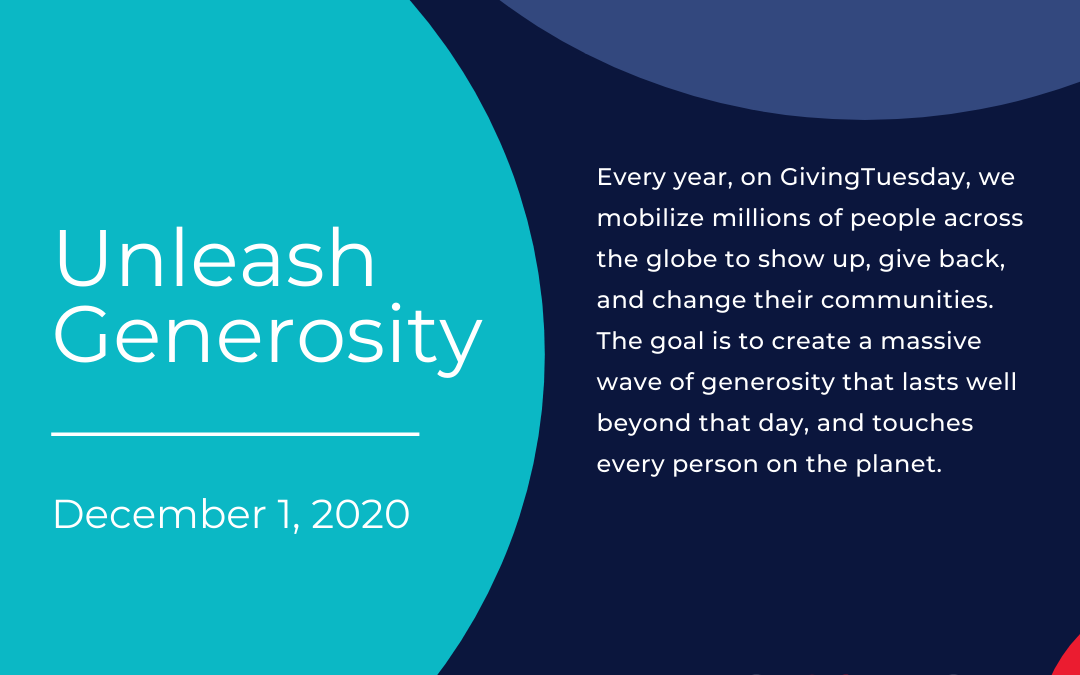
On Tuesday, November 29, Saving Sight will join nonprofits all over the world in a global movement of generosity for Giving Tuesday. We hope you’ll join us in making a gift to support our work in preserving and restoring the sight of others.
Your financial contribution to Saving Sight allows us to continue the important work of educating about eye donation in the communities that we serve. With your support, we’re able to continue to fill our eye, organ and tissue donor registries so more transplant recipients receive the gift of sight. Together, we can engage communities and partners in saving sight for others.
Are you ready to make your impact? Consider making a financial gift today of any amount to help us meet our one-day #GivingTuesday goal of $2,000.
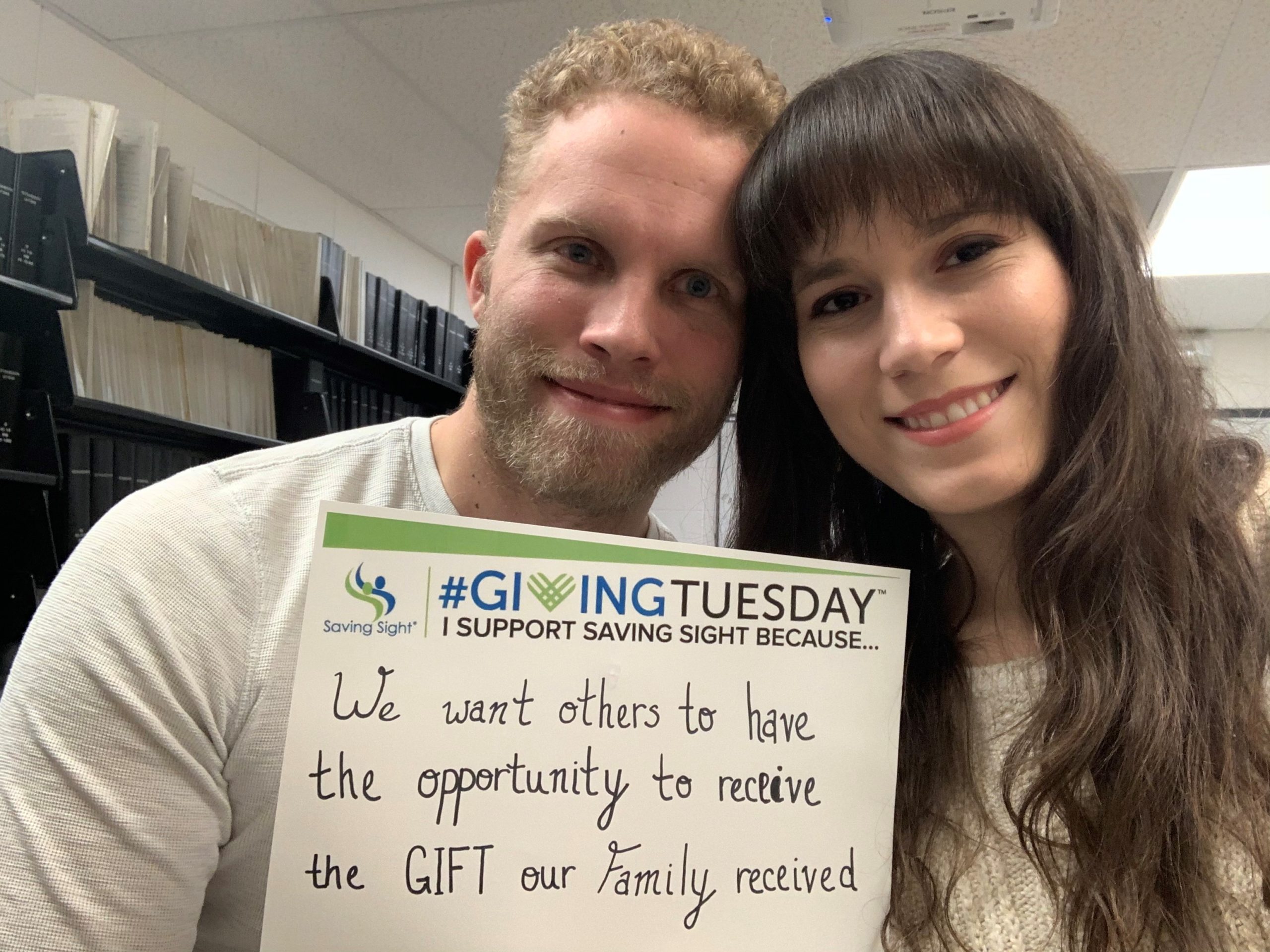
Show your support of our mission on #GivingTuesday by sharing an “unselfie” on social media. Download our template here and share a little with us about why you support our mission.
Day(s)
:
Hour(s)
:
Minute(s)
:
Second(s)
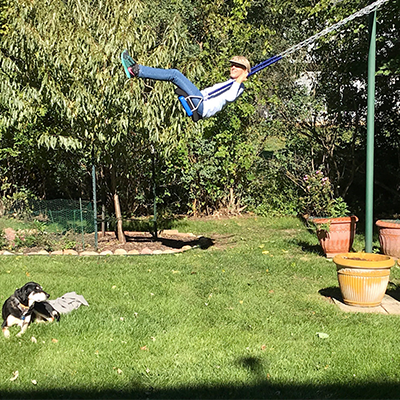
“One of my favorite things to do is swing on the 10-foot-tall swing in my backyard,” says Carol. “I go on it every day and as I’m swinging, I can see everything going on and all the changes in the seasons. Every time I do it, I see something new in my yard and my neighborhood – it’s even better now after my surgeries. It’s my relaxation and my mediation.”
After years of battling the progressive eye disease Fuchs Dystrophy, Carol’s sight was restored through corneal transplantation.

Carol’s Experience with Corneal Transplantation
“I inherited Fuchs Dystrophy from my father, who endured two unsuccessful corneal surgeries in the years before tissue transplants were available. Back when my dad had it, this new technology had not yet been developed. He endured a much more invasive surgery and it didn’t work. The whole thing was terrible for him and I was nervous to get it done. I dealt with that condition for many, many years and tried to treat it with eye drops for 15 years,” she says.
Eventually, Carol realized she needed to have surgery and scheduled an appointment during the middle of the pandemic. She was scared because of her father’s experience but was uncomfortable because her vision was so impaired, and her corneas had become scratchy and dry. “One of my corneas had even blistered,” she adds. Her friend, Dr. Cindy Penzler, who is a respected ophthalmologist in Topeka, recommended she reach out to Dr. Timothy Cavanaugh with Cavanaugh Eye Center in Overland Park, KS for a consultation.
“As soon as I met with Dr. Cavanaugh and went through the extensive eye exam I knew I was in good hands. I was impressed by how educated he is, his passion for it, and his fantastic staff. He just made me feel that confident,” says Carol. “Dr. Cavanaugh’s process is so unique because, not only is he experienced and efficient with DSAEK corneal transplantation, but he was the only surgeon I could find to do simultaneous cataract and corneal procedures. That made it 2 surgeries instead of 4, since I had cataracts on both eyes and needed both corneas replaced. It’s amazing how complicated it is but how well he does it.”
One thing Carol found interesting during her initial exam was viewing the image of a healthy cornea compared to her cornea. Where you can see a cornea full of cells in the healthy cornea, the image of her cornea was just black. Dr. Cavanaugh came in and explained to Carol that was because you could literally see just a few cells left on her cornea.
After her surgery, Dr. Cavanaugh told Carol her donor was a “super donor” explaining that at birth the cornea has 3,000 cells and at death it’s usually around 2,000. Her donor’s cornea had 2,900 cells – and Carol’s diseased cornea had virtual none.
“You can imagine because of that it was a miracle for me. Within 2 to 3 days of the surgery I was seeing better than I ever had and I was still healing. It was life-changing! I was like a kid who just woke up from a black and white dream. Brighter, clearer and truer. And you have to remember I had the cataract surgery as well. When I went back to the next appointment one week later, they said I healed faster than most and I thank my super donor for that.”
After her first surgery in June, Carol had her second cornea transplant in August. “I may still need a prescription at some point but right now I can read and drive without glasses and hadn’t been able to in 30 years – that’s a win for me.”
For Carol, the process has been easy, and her surgeon did everything they could to make her comfortable during the procedure. “After meeting Dr. Cavanaugh, my attitude was I couldn’t wait to get this done. It was all outpatient and I had faith in Dr. Cavanaugh. It was maybe 2 hours at most. Everyone was friendly and upbeat. Nothing about it provided anxiety, pain or nervousness for me. I tend to be someone who can relax myself well though. The only thing that was a little difficult was keeping my head flat/back for 48 hours after to hold cornea transplant in place.”
Life After Restored Vision
Today, Carol is retired after working a majority of her life for an internet publishing company where she sold online and print advertisements for technology companies. Her first grandchild was born in early October. “I got to hold him and look at his face through clear eyes and see it so clearly and feel it so deeply, much more so than I would have before the surgery,” she says.
Reading for Carol is also number one and has been so enhanced by her cornea transplants. “The best thing for me is for the first time in probably 30 years I don’t have to have glasses to read. I read all the time. And I volunteer for the audio reader programmer and it provides a 24/7/365 radio service for the blind and reading impaired. This lets me continue that so much easier. I read and record live shows and newspaper stories for an hour every day. Every single thing in my life is enhanced by good eyesight,” Carol adds.
Connecting through Correspondence
Following her transplants, Carol received a letter in the mail about Saving Sight’s Correspondence Program. “I was so happy to get the letter from Saving Sight about correspondence because I was thinking to myself, how do I thank the person who did this for me – what it has meant to me to be able to see so much better? This allowed me to say thank you to the donor family. I wouldn’t have had access to that information if I wouldn’t have received that letter. I realized it went beyond Dr. Cavanaugh. It began with the donor and it was so nice to be able to close that loop for me and let them know how much I appreciated their loved one being open to donation, to tell them this is what happened. It saved my sight.”
“And I’m just very deeply appreciative of the work that Saving Sight does as well. I can never thank Dr. Cavanaugh or the donor enough for this second lease I have on life. This was a 100 percent uplifting experience for me during the worst pandemic of our lifetime.”
Learning About Organ, Eye and Tissue Donation
“I’m listed as an organ donor and had never thought about eye donation before this. It wasn’t until my surgeries that I thought about this and I just found it so amazing. I have a whole lot of respect for doctors, and researchers and those in the industry who are advancing this field,” says Carol.
“It’s so needed because there are so many common eye diseases that could use corneal tissue to help the patient. It’s a huge contribution people can make through donation – if you contribute nothing more than cornea tissue you have made a significant difference in the lives of others.”
You can join the national registry or learn more about organ eye and tissue donation at registerme.org.

The Missouri Lions have given their volunteer, financial, and board support to our programs since 1960. Because of their support, Saving Sight is able to change more lives by saving sight each and every day. The Saving Sight Board of Directors is comprised of several key Lion members. Their leadership and expertise has helped the eye bank grow and evolve throughout the last 60 years and continues to move us forward into the future.
Read why Pat Martchink, Board President, and Larry Boettcher, Board Vice-President, find serving on Saving Sight’s Board to be impactful.
How long have you served on the Saving Sight Board and in what roles? I am in my fifth year on the Board. One year as a member, one year as Secretary, and now in my third year as President.
Why is it impactful for you to serve on the Saving Sight Board? I have worked professionally in nonprofits for more than 35 years and I believe it is a noble cause. My father was blind for a part of his life so I understand the importance of Saving Sight’s mission. I believe in the idea of “service” and being a part of Saving Sight helps me to fulfill that idea.
How does the Board function to support Saving Sight’s mission to change lives by saving sight? The Board helps to provide the “big picture” for the agency and then supports management to move the agency in that direction.
How have things evolved since you first became connected with Saving Sight? I believe the Board has grown stronger in its support of the Saving Sight leadership. The Board wants Saving Sight to be progressive due to the competition of other eye banks and the for-profit entities businesses that have similar interests.
Is there anything else about your experience as a board member or about Saving Sight you’d like to mention? I am thoroughly impressed by the work ethics of the entire Saving Sight Staff. They work hard and are truly dedicated to the mission of the organization.
How long have you served on the Saving Sight Board and in what roles? This is the beginning of my third year of my first term as a Board member elected to serve Saving Sight from my Lions District 26-M4. Prior to this term I was appointed by the Council of Governors for Missouri Multiple District 26 to serve as a Board member in my Lions capacity as the Vice-Council Chair for one year, and as Council Chair for the second year. I have served as the Board Vice-President for the past two years and I was elected by the board for the current year starting July 1, 2020. This is the beginning of my fourth year on the Executive Committee which meets once a month. Last year, and again this year, I have been appointed to serve on the Finance Committee which meets quarterly or as needed ahead of the Board Meetings.
Why is it impactful for you to serve on the Saving Sight Board? I believe my prior leadership positions that I have held in the Lions Organization along with my formal education, management training and seminars through Lions International, and my 21 year career in management, I bring all of that knowledge and skill set to this Board. One of the things I am known for on the Board is knowing our By-Laws and making sure our decisions follow those set guidelines. I always have my copy of our Board Handbook ready for review at any time, whether it is during a committee meeting or during the Board meetings.
How does the Board function to support Saving Sight’s mission to change lives by saving sight? First, the Board as a Governance Policy that has the guidelines for the Board and for the CEO for the overall operation of the organization. This allows the day to day operation of the organization to go on without constant Board involvement. Second, the Board is responsible for actively participating in long-range planning for the organization along with determining the programs and services provided. As a Board we have to be progressive and always looking to the future for the overall success of the organization. An example is Vital Tears, in 2016 the Board approved the initial investment into creating that joint venture. They did this because they recognized with the Leadership at Saving Sight that there is a growing need for a solution for patients with chronic dry eye that can’t get relief from what was currently available. That part of our business is thriving and growing at an increasing pace. We have to continue to look for the next possibility, do our due diligence with our collaboration with Saving Sight leadership to continue the growth and sustainability of our organization.
How have things evolved since you first became connected with Saving Sight? We have tried to recruit Lions and community members that bring a different perspective to the organization, and a true willingness to serve. We have brought the Board and Saving Sight leadership closer together in our working relationship by taking the effort to fellowship with one another after our meetings and spend time getting to truly know each other. We have focused on Board training including a new On-Boarding program that I developed for our newest board members each year. We have found that by covering all of the information ahead of their first Board meeting we have been able to use our time together in the Board meeting to focus on what needs to be done, rather than answering questions over and over each year.
Historically, how have the Missouri Lions supported Saving Sight? Individual Lions and Individual Lions Clubs have donated money over the years to support the mission. When Saving Sight handled recycled eye-glasses the Lions of Missouri collected the glasses in their locations and brought them to Saving Sight for distribution in third world countries. When Saving Sight controlled the KidSight program the Lions of Missouri volunteered their time and money to support that program. The proceeds from the Missouri Lions All-Star Football game each year was donated to Saving Sight. Over the years the Districts in Missouri and the Multiple District raised money for matching grants through Lions Clubs International Foundation to purchase equipment for the labs.
Is there anything else about your experience as a board member or about Saving Sight you’d like to mention? I can honestly say that I enjoy serving on this board. This isn’t a mundane meeting that you just dread going to, because what we do does make a difference and has a profound impact on our communities. Not only for our employees, but for all of those patients that have restored eye sight or relief from their dry eye. I believe in what we do so much I personally support the organization through monthly giving.

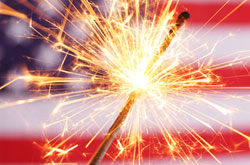
The U.S. Consumer Product Safety Commission reports that there are 9,000 fireworks-related injuries each year in the U.S. Thirty percent of those are eye injuries, and one-fourth of those eye injuries result in blindness. What’s more, children account for the majority of fireworks-injury victims, and for children under 5, sparklers — which burn at 2,000 degrees Fahrenheit and can cause third-degree burns — account for one-third of fireworks-related injuries.
For these reasons, the American Academy of Ophthalmology encourages you to follow these recommendations:
If you do decide to shoot off fireworks yourself, be sure to follow all safety precautions, protect your eyes, and keep children a safe distance away. The staff at Saving Sight wishes you a safe and fun-filled Independence Day weekend.
Sources: EyeSmart and the American Academy of Ophthalmology.